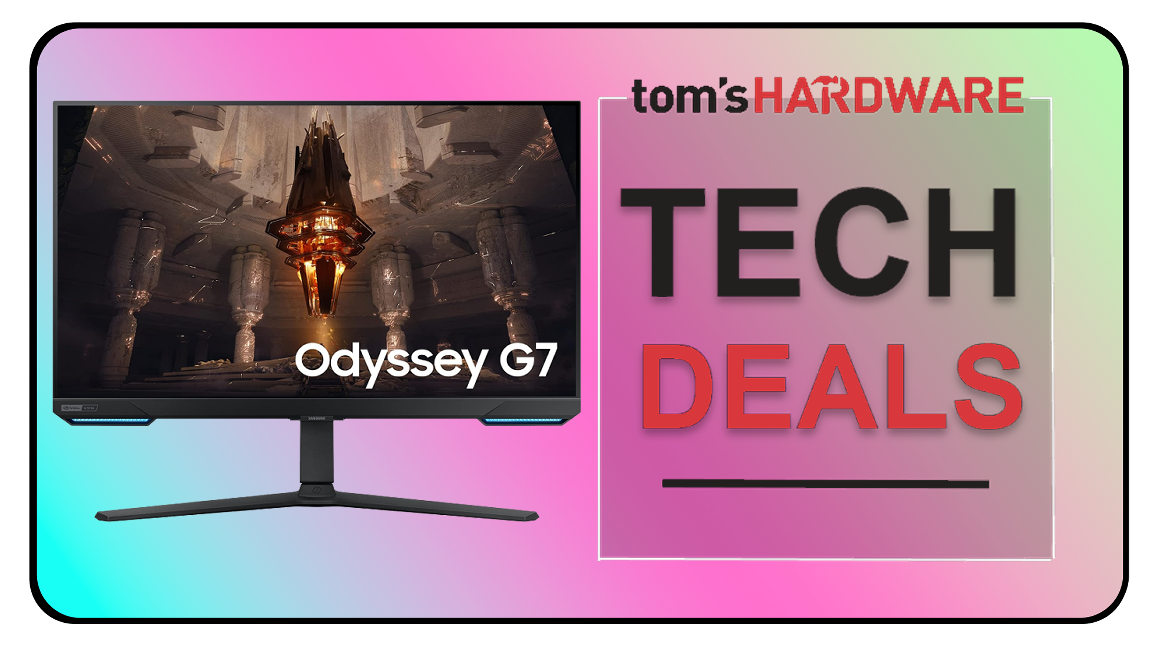Germany’s IFA trade show is typically more about coffee makers and smart-home tech than CPUs and cool laptop concepts. But with Intel and Qualcomm launching major new mobile platforms in the days leading up to the main event — Lunar Lake and lower-cost, 8-core variants of the Snapdragon X Plus — we knew there would be plenty of important and exciting products to cover.
So we descended on Berlin, and soon found ourselves overwhelmed with new laptops (and crazy laptop concepts), next-gen gaming handheldsmulti-screen keyboards, and AIof course. chip makers and laptop designers are still trying to convince us (and consumers) that AI is the biggest tech advancement since the internet — but despite some new features and advances on the NPU side, it still feels like the early dial-up days at best.
There was nevertheless a whole lot of new hardware on display at IFA to get excited about, giving us a glimpse of what to expect in the near and not-so-near future, from power-efficient ultraportables to 600-Hz monitors and laptops that blur the line between console and PC. We’ve gathered the best of what our editors saw at IFA below. What new products and announcements are you most excited about from the show? Let us know in the comments.
Intel Core Ultra (Series 2) “Lunar Lake” 200V
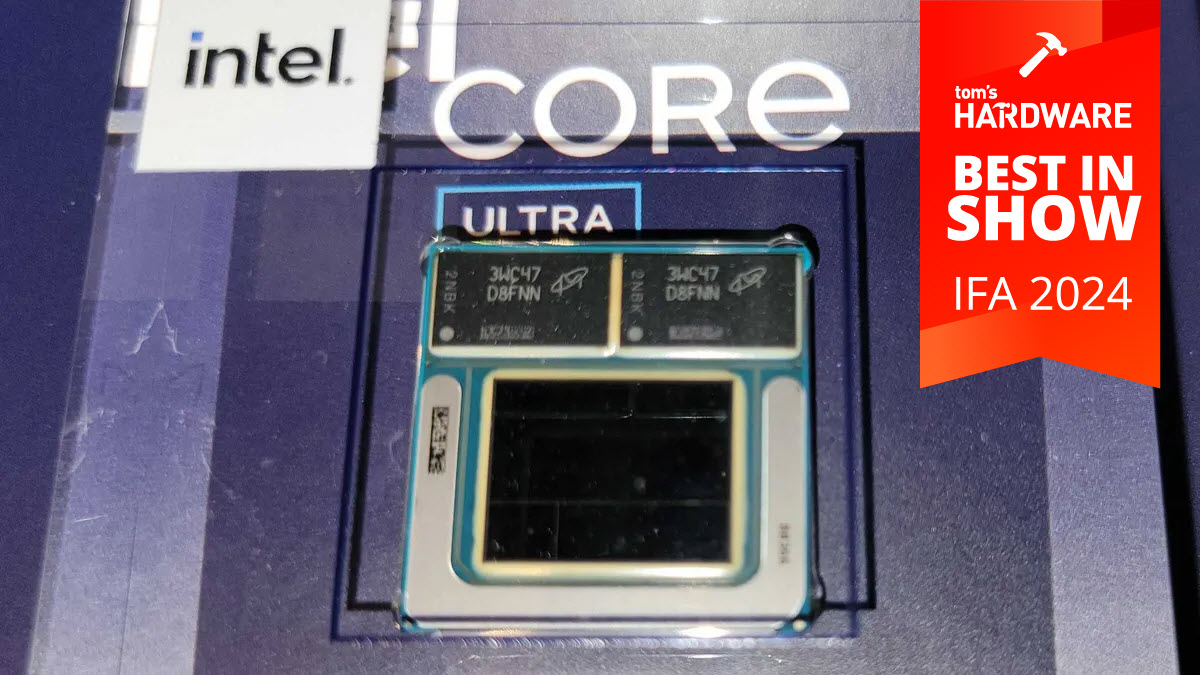
By far the most interesting silicon at IFA, Intel’s Lunar Lake processors are here to take on Qualcomm’s Arm-based processors: The company promises “historic” x86 power efficiency, with a claim of 1.2 times more performance-per-watt than the Qualcomm Snapdragon X Elite X1E-80-100 and 2.29 times more performance-per-watt than Intel’s previous-generation”Meteor Lake” Ultra 7 165H.
Add in some pretty extreme battery life claims for x86 systems, like up to 20.1 hours of battery life with the Core Ultra 7 268V in UL Procyon Office Productivity and 10.7 hours in Microsoft Teams.
Without hyperthreading, Intel claims you get 15% more performance on P-Cores at the same power as Meteor Lake and a 30% overall gain in power/performance metrics. Intel suggests its architectural changes give Lunar Lake the fastest CPU cores on the market. And this is all with full compatibility with years and years of applications.
Throw in some bold claims about the new Arc graphics, including a 31% improvement over Meteor Lake’s Arc graphics and a 16% performance advantage over AMD’s Ryzen HX 370, and it really seems like the integrated graphics race is back.
With as many as 120 TOPS between the CPU, GPU, and NPU, it also puts Intel back in the race on AI, as long as you don’t focus exclusively on the NPU. This all makes for a very interesting — and crucial — line of mobile chips for Intel, and with a handful of premium designs at IFA, it’s looking exciting.
Read: Intel launches Lunar Lake: claims Arm-beating battery life, world’s fastest mobile CPU cores
— Andrew E. Freedman
Lenovo Auto Twist AI PC
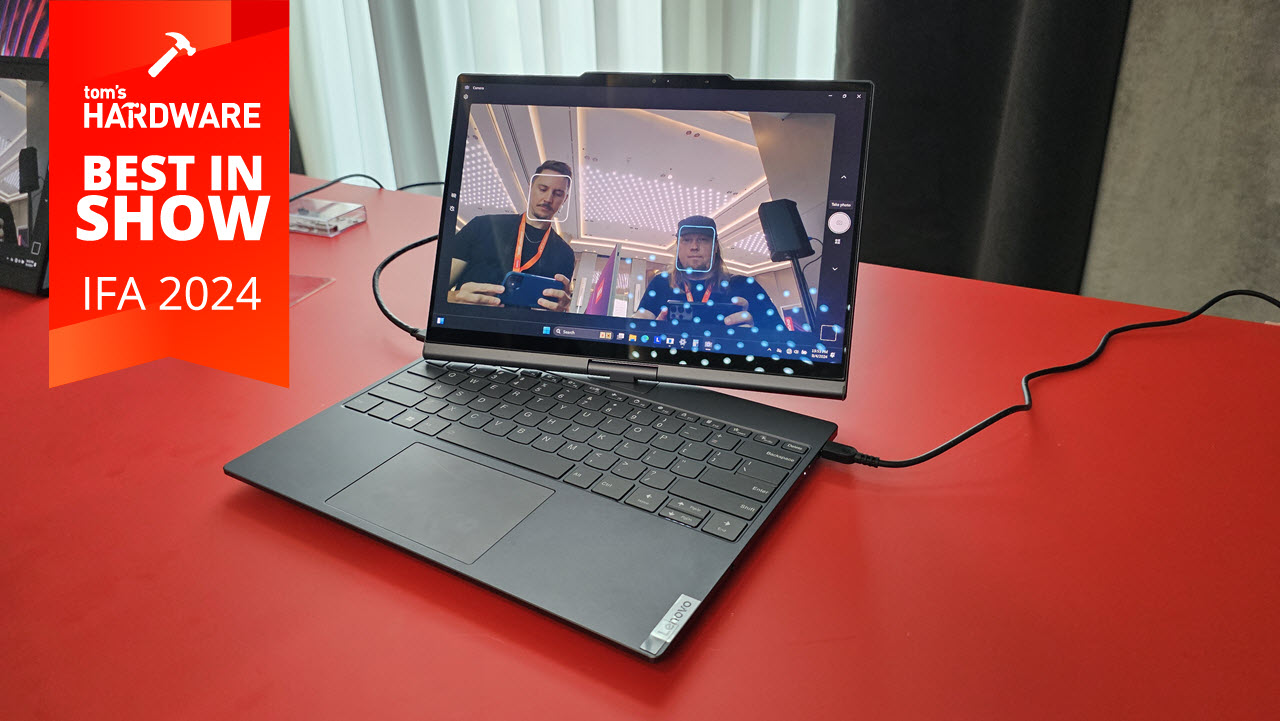
Lenovo’s IFA concept laptop sports a motorized hinge that can open, close, and convert the device via voice commands, as well as swivel and tilt (Lenovo calls it a “Dual Degree of Freedom” mechanism) to make sure you’re always in frame as you move around the room giving presentations. It’ll even close the lid when you walk away.
And sure, that can seem a bit gimmicky, or a niche feature for executives who don’t like to sit down. But it’s also the most sci-fi-like feature I’ve seen on a laptop in a long time. And there are plenty of people with accessibility issues that a device like this could really help. It is just a concept, so it’s unclear if any of the Auto Twist’s motorized moves will make it into a laptop you can actually buy someday. But if it does, we hope Lenovo does some more work to minimize the screen wobble, and a lot of work to make sure the very complicated hinge can hold up to the kinds of everyday stresses years-long use that people expect from every other ThinkBook.
Read: Lenovo’s Auto Twist AI PC IFA concept has a motorized hinge that can follow you around and close itself via voice command
— Matt Safford
Acer Nitro XV240 F6 600 Hz Gaming Monitor
There’s an ongoing war brewing between monitor manufacturers regarding high refresh rate displays. Alienware first caught our eye with the 500 Hz AW2524H in 2023, and the battle has only intensified since then. Now, Acer has reached the 600 Hz milestone with its Nitro XV240 F6.
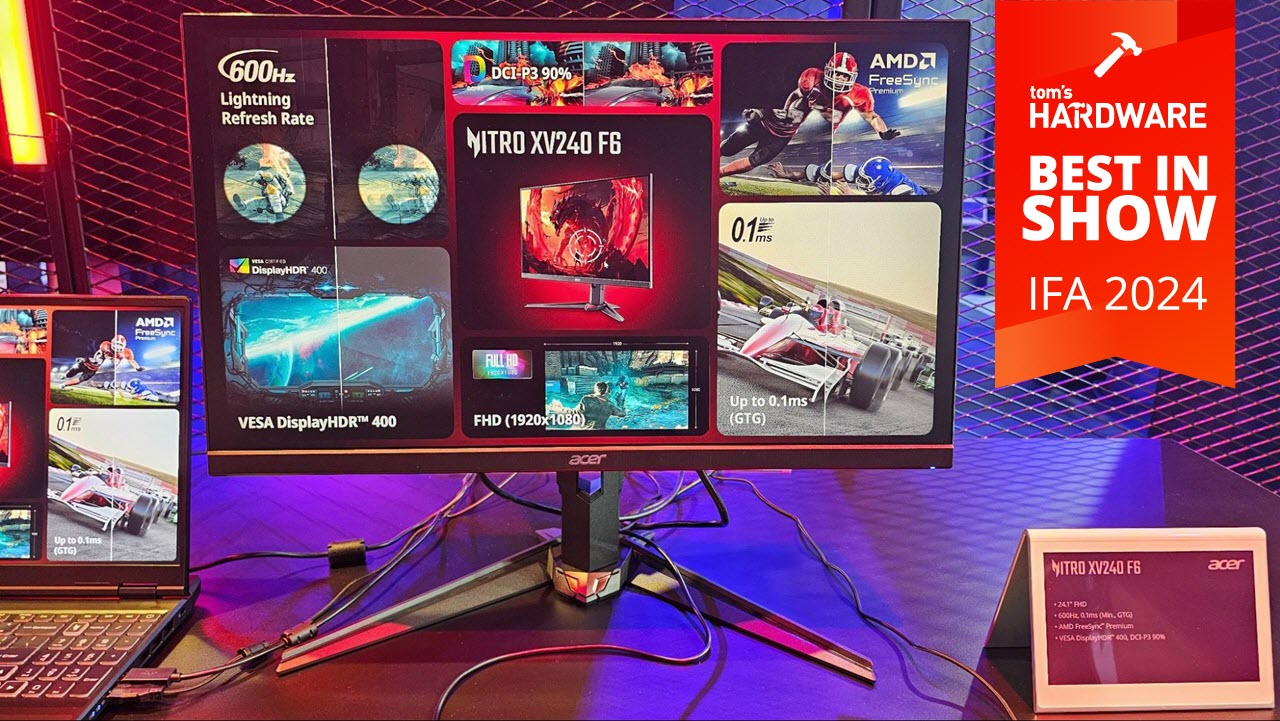
The Nitro XV240 F6 is a 24-inch monitor using a TN (twisted nematic) panel, which isn’t as common as competing IPS, VAand OLED technologies. However, the TN panel allows the monitor to hit 600 Hz with a 0.1 ms gray-to-gray response time at Full HD (1920 x 1080) resolution with full support for AMD FreeSync Premium. That blazing-fast refresh rate is only available via a DisplayPort connection. If you opt for HDMI connectivity, you’re limited to 240 Hz at Full HD resolution.
Acer claims 95 percent coverage of DCI-P3, and maximum brightness is listed at 400 nits. Two HDMI 2.1 ports and one DisplayPort 1.4 connection are provided, and the Nitro XV240 F6 includes two 2W speakers.
With so many superlatives on the performance front, the only real downer is that the Acer Nitro XV240 F6 won’t be available in the United States until the first quarter of 2025. Upon launch, the monitor will be priced at $599.99, and we’ll definitely be ready to give you one of the first reviews of a compelling candidate to join the ranks of the best gaming monitors.
Read: Acer brings blazing fast 600 Hz, 520 Hz FHD gaming monitors to IFA
—Brandon Hill
Asus Zenbook S14

Other than its new Intel Lunar Lake CPUs (Core Ultra 7 256V in the US), the Asus Zenbook S14 looks like a minor refresh of recent models, with its distinctive ceramic aluminum lid (in white or gray hues) and inclusion of USB-C and USB-A ports, plus full-sized HDMI – despite its svelte sub-half-inch thickness and roughly 2.5-pound weight. Its 16:10, 2880 x 1800, 120 Hz display is also familiar, making for a laptop that really doesn’t look all that new.
And yet, of the many laptops I saw at IFA, the Zenbook S14 was one of the nicest-looking and nicest-feeling of that considerable bunch. I can’t wait to test it and see what kind of battery life it can deliver with Intel’s new silicon and its 72Whr battery – and how good its slim chassis is at handling the heat. Slim laptops often struggle on that front, but if Intel’s claims about Lunar Lake’s efficiency are true, maybe that will be less of an issue with this latest round of laptops.
Read: Asus brings Intel Lunar Lake to Zenbook and Vivobook S14
— Matt Safford
Lenovo ThinkPad X1 Carbon (Gen 13) Aura Edition
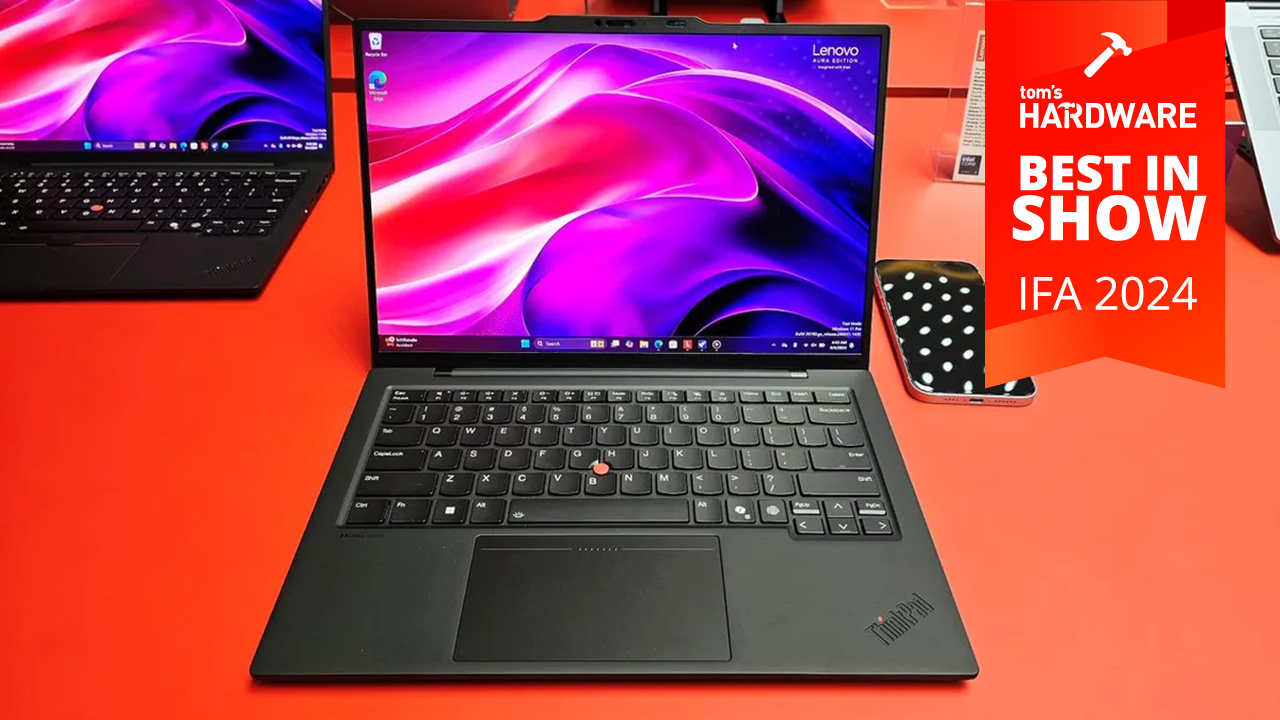
For the last decade plus, Lenovo’s ThinkPad X1 Carbon has been among the best ultraportable laptops you can buy overall, thanks to its combination of thin design, light weight, plenty of ports, best-in-class keyboard and good battery life. Now, with the 13th Generation X1 Carbon, Lenovo is taking its flagship business laptop to another level. Using Intel’s new Lunar Lake chips, the company has managed to shave the Carbon’s weight down to 2.16 pounds from its previous low of 2.42 pounds while still packing in a 57 Whr battery and including all the ports most people would want: two Thunderbolt 4 connections, two USB Type-A ports and a full-size HDMI out.
The company claims that the new Carbon will get up to 18 hours of battery life, which would be an improvement over the 9 hours the 12th Gen X1 Carbon got on our endurance benchmark if it can deliver under the same conditions. Meanwhile, the Intel Lunar Lake processor provides up to 48 TOPS via its NPU and 67 TOPS via its GPU, enough for demanding local AI workloads.
The X1 Carbon (Gen 13) has the words “Aura Edition” at the end of its name because it’s part of Lenovo and Intel’s “Aura” program where the two companies add extra features that improve the usability of select Lunar Lake laptops (so far, just the X1 Carbon and the new Yoga Slim 7i). Aura Edition features include Smart Share, which allows you to transfer files from your phone by tapping the laptop’s bezel, and Smart Modes, which help you maintain your attention, security and health.
The X1 Carbon (Gen 13) Aura Edition is due out in November with a starting price of $1,999. It will come standard with a 2.8K OLED screen and Wi-Fi 7 connectivity.
Read: Lenovo’s Lunar Lake-powered X1 Carbon Aura Edition weighs just 2.16 pounds
– Avram Piltch
MSI Stealth AI 16+
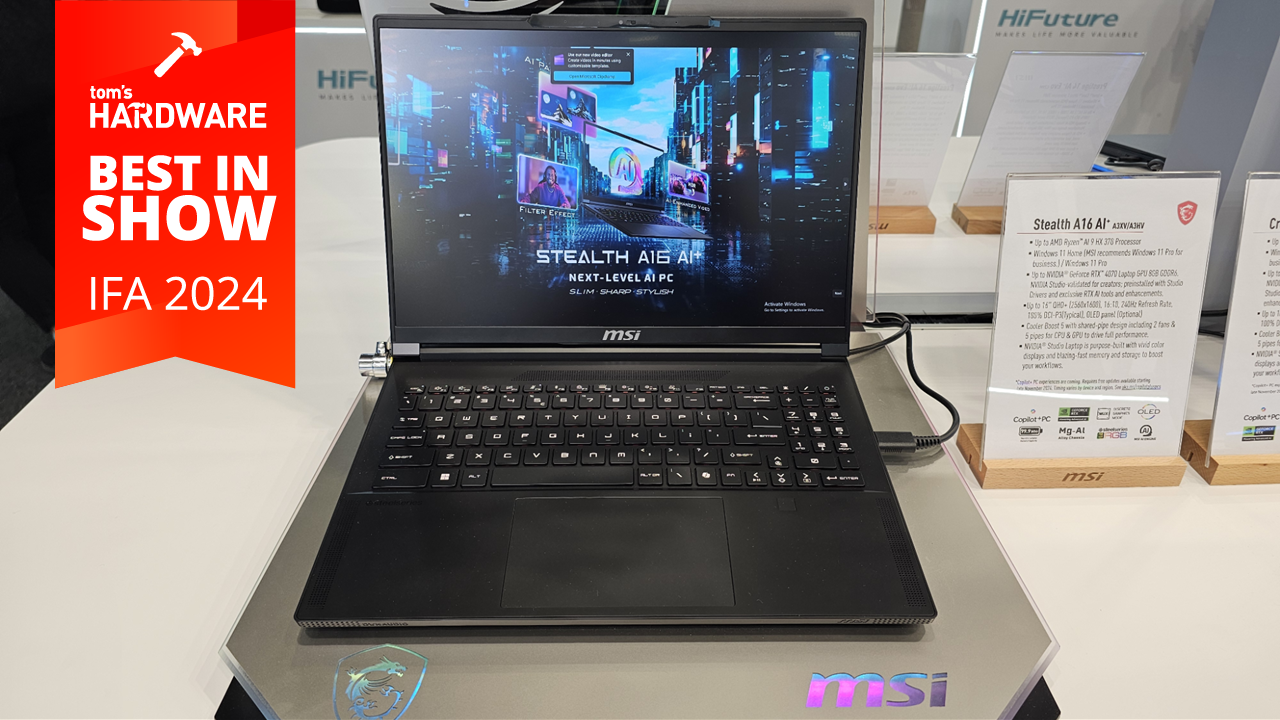
Everyone at IFA continues to talk about AI. And while plenty of laptops now have NPUs, the MSI Stealth AI 16+ has a bit of a unique proposition: a Ryzen 9 AI HX 370 that should see Copilot+ support soon, as well as a discrete GPU going up to an Nvidia GeForce RTX 4070. When combined, this offers plenty of TOPS across the system.
You’re getting a 99.9 WHr battery — the largest you can take on a plane, crammed into a magnesium-aluminum chassis that’s just 0.78 inches thick. There’s also a per-key RGB keyboard (courtesy of SteelSeries, as usual on MSI gaming laptops), six speakers, and a massive touchpad.
MSI isn’t talking about pricing — we expect it to be expensive. But the Stealth is offering a unique value proposition for AI workloads and gaming on the go.
Read: MSI’s new productivity laptops boast Intel Lunar Lake and AMD Ryzen AI 300
— Andrew E. Freedman
Acer Project DualPlay
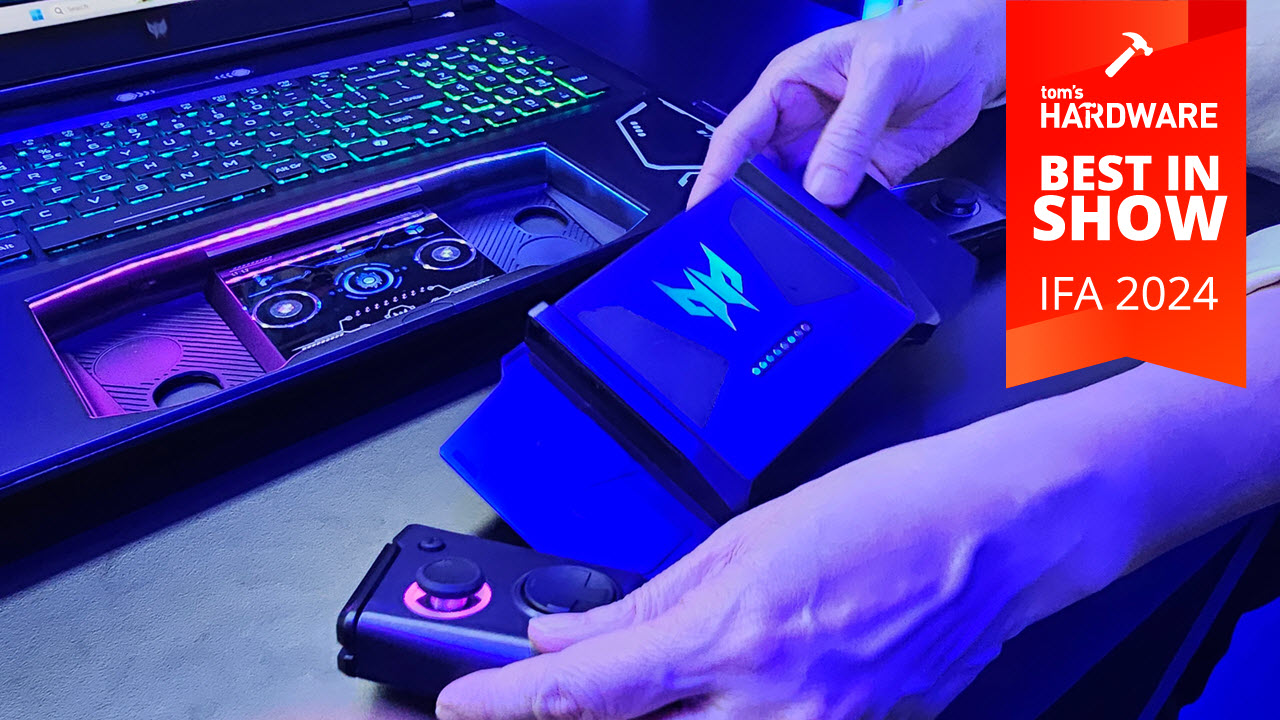
While many PC gamers prefer to play with keyboard and mouse, some games are just better when you sit back with a controller. Acer’s Project DualPlay crams a controller on the underside of the touchpad, with two Nintendo Switch-style Joycons and a grip to hold them together.
Tom’s Hardware Managing Editor Matt Safford saw the device, and reports that he was surprised by the fit and finish from this concept device. While it doesn’t seem there’s a plan to put it on sale, it wouldn’t be Acer’s first time marketing something over the top.
It’s a lot of engineering to build these controllers inside a laptop — especially when you could go buy an Xbox controller for $50 and carry it with you. But we’ve never seen something quite like this before, and you never know when you’ll want to make a swap between play styles.
Read: Acer’s shows off DualPlay laptop with controller that pops out of the touchpad
— Andrew E. Freedman
Epomaker RT80
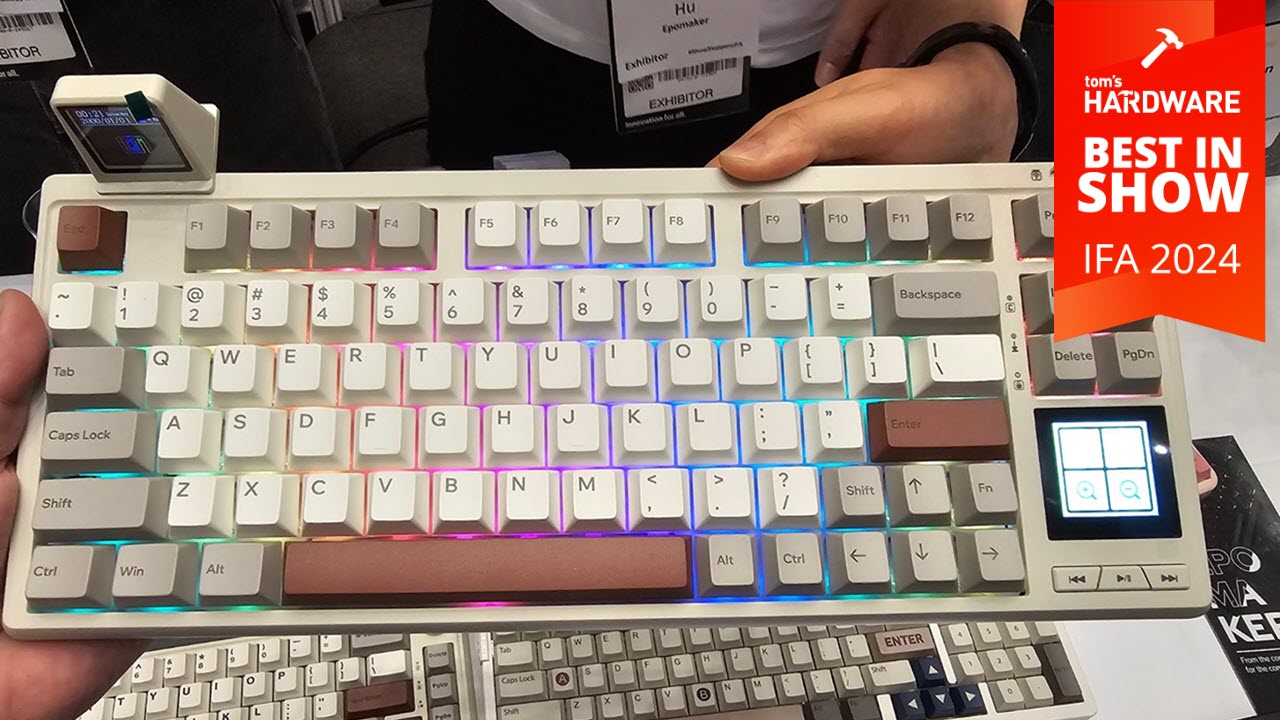
Lots of keyboards have a screen these days, but Epomaker’s RT80 has two. The first, in the upper left, is removable and for displaying things like stats. The second, in the bottom right, is a customizable touch screen that can be used for handy shortcuts such as copy and paste, volume control, or zoom levels. It’s almost like having a mini Stream Deck on your keyboard, without taking up any extra desk space.
Details are scarce about the RT80 as of this writing. We don’t know the price or availability, but we will update this section when we do. What we do know is that the keyboard is wireless, it uses the company’s Flamingo linear switches, and we want to test it with our own workflow to see just what we can accomplish with this much flexibility at our fingertips.
— Matt Safford


